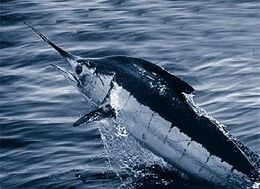
Male
This species is known for its long bill that grows from the front of its head. Blue marlin use this bill to stun their prey by slashing their heads in a side-to-side motion, knocking potential prey unconscious, and making it easier to catch. The blue marlin’s bill differs from the swordfish’s by being round and pointed, rather than flat and blunt. Like many open ocean bony fishes, blue marlin start out as extremely tiny larvae, no more than a few millimeters long and weighing only a few hundredths of a gram. Soon after hatching, they already have a visible bill. Blue Marlin grow rapidly, and in the course of their lives they may increase their body weight by at least one million times!
Because blue marlin undergo such an amazing transformation in size (from being nearly microscopic to being one of the largest open ocean predators), they eat a wide variety of prey, throughout their lifetimes. At a young age, they eat tiny zooplankton, and their prey increases in size as they do. As adults, they eat fairly large bony fishes and squids. Similarly, blue marlin are eaten by a wide variety of predators. When they are newly hatched, they are eaten by other fishes that specialize on eating plankton. The size of their predators increases as they grow, and adult blue marlin are not eaten by anything other than large open ocean shark species.
The blue marlin is a highly migratory species, with individuals migrating across entire ocean basins and even between oceans. One individual, for example, was tagged off the east coast of the United States (western Atlantic Ocean) and recaptured in the Indian Ocean. Like many migratory species, the females are larger than males. In fact, adult female blue marlin are as much as four times the size of the largest males. All of the largest individuals are female. blue marlin reproduce through external (rather than internal) fertilization, where the female releases her eggs into the water column while the male releases his sperm. Once the sperm find the eggs, fertilization occurs. While spawning, a single female may release several million eggs, increasing the likelihood that some will be fertilized and that at least one hatched larva will grow to reach adulthood. Though almost all fishes are cold blooded, blue marlin and the other billfishes have a specialized blood vessel structure – called a countercurrent exchanger – that allows them to warm their brains and eyes. This adaptation provides them with a major advantage when hunting, by allowing them to think more quickly and see more clearly.
The blue marlin is a targeted fishery species in only a limited number of areas but is captured as accidental bycatch in fisheries targeting other species throughout its range. In some areas, this accidental capture is threatening blue marlin populations, and scientists consider the species vulnerable to extinction. Generally speaking, blue marlin populations are decreasing in numbers. Though it is not targeted commercially throughout much of its range, the blue marlin is one of the most highly sought after big game fishes in the world. Sport fishing enthusiasts spend tens of thousands of dollars to catch large blue marlin, and they are typically released alive (though recent data suggests that released individuals may frequently die after the fact). If numbers continue to decline, this highly valuable sport fishery may be in danger of collapse.
Taxonomy note: Several times throughout the history of studying marine fishes, researchers have divided the blue marlin into multiple species, but recent genetic studies leads scientists to believe that all blue marlin around the world are the same species.